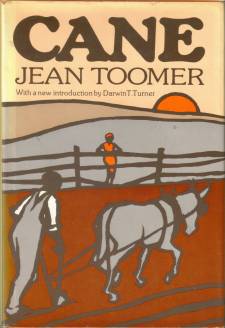The last blog post pointed out the influence that Ernest Hemingway
had on Gaines and his writing. Hemingway influenced numerous black authors from
Claude McKay, Ralph Ellison, Gloria Naylor, and Derek Walcott. What some may
not know, however, is that an African American author influenced Hemingway
himself. Jean Toomer’s Cane (1923) appeared at a time when the
short story cycle arose more predominantly in the literary scene.
Sherwood Anderson, the author of the short story cycle Winesburg, Ohio (1919) told Gertrude Stein in 1924
that she should read Toomer’s Cane.
Stein and Anderson both mentored Hemingway, so "it is a virtual
certainty," as Gary
Holcomb writes, that
"Hemingway was acquainted with Toomer's book" (311).
Gaines has stated that African American authors such as Richard Wright did not have an influence on his writing when he started. He has cited Ivan Turgenev, Fydor Dostoyevsky, Leo Tolstoy, James Joyce, Ernest Hemingway, William Faulkner, John Steinbeck, Willa Cather, Sherwood Anderson, and others as influences. Gaines states, “I didn’t read Cane until after I got out of college. I didn’t read Cane until about ’59 or ’60. By then I had developed what I suppose is my way of writing” (Gaudet and Wooton 35). In a 1994 interview with John Lowe, Gaines outlines the relationship between Hemingway and Toomer explicitly:
Gaines has stated that African American authors such as Richard Wright did not have an influence on his writing when he started. He has cited Ivan Turgenev, Fydor Dostoyevsky, Leo Tolstoy, James Joyce, Ernest Hemingway, William Faulkner, John Steinbeck, Willa Cather, Sherwood Anderson, and others as influences. Gaines states, “I didn’t read Cane until after I got out of college. I didn’t read Cane until about ’59 or ’60. By then I had developed what I suppose is my way of writing” (Gaudet and Wooton 35). In a 1994 interview with John Lowe, Gaines outlines the relationship between Hemingway and Toomer explicitly:
I discovered Cane in the sixties. I thought it was so poetic—you know, Sherwood Anderson knew about that book, and I’m almost certain he mentioned it to Gertrude Stein and Hemingway because of those little things in Hemingway’s first collection of stories, In Our Time—he has those little breaks between each one of those stories, and I wonder if he didn’t get that from having read Toomer’s Cane; and of course, Cane came out much earlier. (317)
Hemingway taught Gaines structure and understatement among other
things, and Gaines sites those as characteristics in regards to Toomer’s
writing in Cane. Looking
at “Karintha” and “Esther” from Cane in comparison with Catherine Carmier one can see how Gaines, through his
admiration for Hemingway, indirectly received inspiration from Toomer.
Gary Holcomb's book, which he co-edited with Charles Scruggs, Hemingway and theBlack Renaissance contains 10 essays that lay out the literary connections between Ernest Hemingway and black authors such as Claude McKay, Ralph Ellison, James Baldwin, Toni Morrison, and others.
Holcomb, Gary Edward. "Race and Ethnicity: African
Americans." Ernest Hemingway in Context. Eds.
Debra A. Moddelmog and Suzzane del Gizzo. Cambridge: Cambridge University
Press, 2013. 307-314. Print.
Lowe, John. "An Interview with Ernest Gaines." Conversations with Ernest Gaines. Ed. John Lowe. Jackson: University of
Mississippi Press, 1995. 297-328. Print.

No comments:
Post a Comment